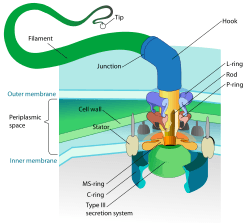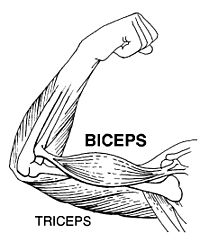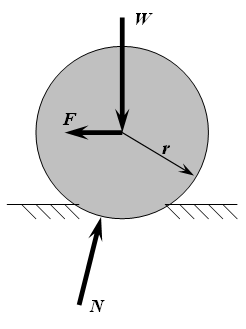Rolling and wheels in the natural world facts for kids
There are two main ways that things, both natural and man-made, can use spinning to move. One way is for the whole thing to roll along. The other way is for just a part of it to spin, like a wheel or a propeller, while the rest stays still. Some living things move by rolling, but no living things seem to use wheels. Scientists who study life, called biologists, have thought a lot about why this is. However, writers of science fiction and fantasy have imagined many animals with wheels.
Wheels are a very helpful technology for people. Many technologies we use are also found in nature, like wings and lenses. So, it might seem strange that wheels have never evolved in nature. There are two main reasons for this. First, there are natural limits to what kinds of things can exist in nature. Living things change slowly over time through a process called evolution by natural selection. This process can find many solutions to a problem, but it can't always create every possible solution. Also, the ways new living things build themselves (called developmental biology) can't always create every kind of body part. Second, wheels are sometimes less useful than other ways of moving, like walking, running, or sliding like a snake. For this reason, some groups of people in the past even stopped using wheels completely.
Contents
Animals That Roll or Spin
Animals That Roll Their Whole Body
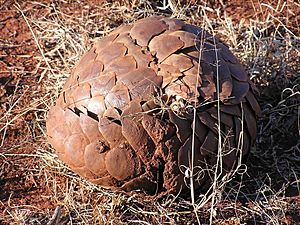
Some living things move by rolling their entire body. These are not true examples of wheels, because the whole creature spins. There are no parts that stay still, like an axle.
Some animals curl their bodies into a circle. They might do this to protect themselves, or to be able to roll. Animals that do this include some caterpillars, tiger beetle larvae, and salamanders. Other animals curl into a ball instead. These include pangolins, hedgehogs, armadillos, and the wheel spider. These animals might roll passively, meaning they are pushed by gravity or wind. Or they might roll actively, by changing their shape to push themselves. Tumbleweeds are parts of plants that break off from their roots and roll in the wind to spread their seeds.
Dung beetles make round balls of animal waste and roll them with their bodies. Even though the ball rolls instead of the beetle, the beetles face many of the same challenges as rolling animals.
A type of skin cell called a keratinocyte moves by rolling. This happens when a wound is healing.
A tiny animal called a rotifer uses a ring of cilia (small hair-like parts) that move in a rhythm to help it move and eat. The word "rotifer" means "having wheels" in Latin, but rotifers don't actually have any parts that truly spin.
Tiny Life Forms With Spinning Parts
No known multicellular organism (an animal or plant made of many cells) can spin part of its body while keeping the rest still. However, there are at least two examples of spinning parts used by single cells. One example is a molecule called ATP synthase. This molecule helps store and move energy inside cells. For example, it's used in photosynthesis (how plants get energy from the sun) and in releasing stored energy.
The only known example in nature of a part that can spin all the way around to push an organism is the flagellum. A flagellum is like a tail that works like a propeller to push single-celled creatures called prokaryotes. The bacterial flagellum is the most famous example. About half of all known bacteria have at least one flagellum. This means that spinning parts might actually be the most common way of moving around in nature!
At the bottom of the bacterial flagellum, where it connects to the cell membrane, a protein acts like an engine. This engine gets its power from the flow of protons (tiny parts of atoms) across the cell membrane. This flow is caused by differences in the number of protons on each side of the membrane, created by the cell's energy processes. Flagella are very efficient, meaning they don't waste much energy. They can push bacteria as fast as 60 times their own length every second.
Organisms called archaea, which are different from bacteria, also use flagella that spin. These two types of flagella developed from different parts. More complex cells, like those in plants and animals (called eukaryotic cells), also have flagella called cilia. But these cilia don't spin at the bottom. Instead, they bend so their tip moves in a circle.
Why Animals Don't Have Wheels
Evolution's Limits
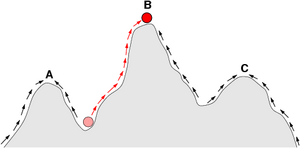
The science of evolution helps explain why animals and plants haven't developed wheels. Simply put, a complex body part (one made of several pieces working together) can't evolve unless its early, unfinished form helps the organism live and have children.
In evolution, useful changes appear slowly over many generations through natural selection. Because of this, changes usually only spread if they don't harm the individual. Large changes that take many steps can only spread if each step makes the organism better. The biologist Richard Dawkins used a picture to explain this. He said that wheels might be a great solution, but getting there would mean going through a "deep valley" where the changes would be harmful first. Evolution can only build with parts that are already available.
This explains why wheels haven't appeared. A wheel without all its important parts probably wouldn't help an organism much. However, the flagellum (the spinning tail) is different. As it evolved, different parts of other structures were used for a new purpose. This use of existing parts for a new job is called exaptation.
Body Building Challenges
People have found it quite easy to build wheeled machines. They have solved problems like how to send power to the wheels and how to reduce friction (rubbing). However, the ways living organisms build themselves are very different from how humans build machines. It's not clear that living processes could make a wheel.
The biggest challenge for animals with wheels is the connection point between the parts that move and the parts that stay still. Wheels need to be able to spin freely compared to the rest of the body. Animal joints can only move a certain amount, but wheels need to spin all the way around without needing to turn back. Because of this, wheels can't be attached to the axle they spin on. No true animal is known to grow solid tissues or organs that are not attached to the rest of the body.
Powering Wheels
To make a wheel turn, something must put a twisting force (called torque) on it. In machines made by people, this torque usually comes from a motor. In animals, movement usually comes from muscles. These muscles get energy by breaking down food. Muscles are attached to the bones they move, so they wouldn't be useful for directly spinning a wheel. Also, animals use their muscles in cycles, moving joints back and forth, not constantly in one direction.
Dealing with Friction
In most machines, a lubricant (like oil) or a bearing is used to reduce friction between moving parts. Keeping friction low is important to prevent damage and stop parts from getting too hot. In animal joints, like the human knee, friction is reduced by a soft tissue called cartilage and a slippery fluid called synovial fluid. A similar fluid or material could help an animal wheel spin freely, but nothing like this has ever been seen in nature.
Feeding and Cleaning Wheels
Another problem is how to get food and oxygen to a living wheel and take away waste. If the wheel's tissues are alive, they need a constant supply of nutrients and oxygen, and waste must be removed. A normal animal circulatory system (the network of tubes that carry blood) wouldn't be able to provide for this flow of materials to a spinning part. Without blood flow, materials would have to spread slowly (called diffusion) to and from the wheel. For large animals, diffusion wouldn't be enough to keep the tissues alive. Instead of a living wheel, a wheel could be made of dead material like keratin, which makes up hair and nails.
Challenges of Using Wheels
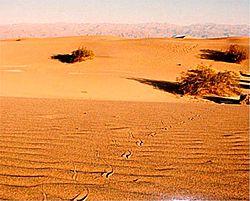
In some places, wheels are simply not as good as legs for moving around. So, even if wheels could evolve, they might not be common in nature. In fact, given the limits of wheels, we could ask: "Why don't people build more machines with legs?" In engineering, wheels are often used because legs are more complex to design and control, not always because wheels do the job better.
Energy Use
Rolling Resistance
On hard, flat ground, like paved roads, hard wheels use less energy than other ways of moving. However, wheels are not as efficient on soft surfaces, like soil, because they have to deal with "rolling resistance". This happens when a vehicle loses energy as the wheel and the surface change shape, and the surface pushes back against the wheel. Smaller wheels have more resistance for their size than larger wheels. Softer surfaces change shape more and don't return to their original shape as well, causing greater resistance. Compared to concrete, the resistance on medium-hard soil can be five to eight times greater, and on sand it can be ten to fifteen times greater. While wheels must change the surface along their entire path, legs only cause a small change where the foot touches the ground.
Rolling resistance is also why some human civilizations stopped using wheels. During the Roman Empire, wheeled chariots were common in the Middle East and North Africa. But when the Empire ended, wheels became less useful to the local people. They started using camels to carry goods in the sandy desert climate. Without maintained roads, camels needed less human effort and water than a cart pulled by oxen.
Dealing with Obstacles
Wheels are not good at dealing with vertical (upright) obstacles, especially those about the same size as the wheel itself. If a vehicle or animal can move its center of mass, the tallest obstacle it can climb is half as high as the wheel. If the center of mass cannot be moved, the highest obstacle is only one-eighth to one-quarter the height of the wheel.
Also, without joints, a wheeled vehicle can get stuck on top of an obstacle if the obstacle is between the wheels and they can't touch the ground. Legs, unlike wheels, are useful for climbing and can handle difficult ground.
Legs Do More Jobs
Animals use their legs for many things besides just moving. They use them for holding and moving objects, climbing, swinging from branches, swimming, digging, jumping, throwing, kicking, and grooming. Without joints, wheels are not as useful as legs for these jobs.
Rolling and Wheeled Creatures in Stories
Rolling Creatures in Fiction
The hoop snake is an animal from legend in the United States and Australia. The snake is said to hold its tail in its mouth and roll like a wheel towards its victims. The Japanese Tsuchinoko is a similar legendary animal.
In the 1944 science fiction story "Arena" by Fredric Brown, there's a mind-reading alien called an "Outsider." It's shaped like a ball and moves by rolling. A 1967 Star Trek episode with the same name was based on this story.
The Dutch artist M. C. Escher created an animal he called Pedalternorotandomovens centroculatus articulosus. This animal could roll itself forward like a wheel. Escher drew it in his 1951 picture Wentelteefje (also known as Curl-up).
A 1956 Scrooge McDuck comic by Carl Barks, Land Beneath the Ground!, featured "Terries" and "Fermies." These characters moved by rolling like a bowling ball.
Tuf Voyaging, a 1986 science fiction novel by George R. R. Martin, includes an alien called a "Rolleram." It kills its victims by rolling over them.
In the Sonic the Hedgehog video game series, the main character Sonic and his sidekick Tails move by rolling. The Sonic the Hedgehog series first appeared in 1991.
Wheeled Creatures in Fiction
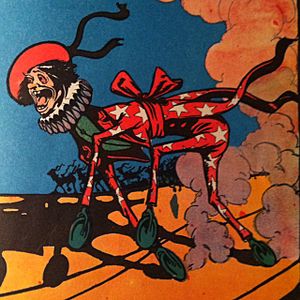
L. Frank Baum's 1907 children's book Ozma of Oz features human-like creatures with wheels instead of hands and feet. They are called "Wheelers."
The 1968 novel The Goblin Reservation by Clifford D. Simak includes an intelligent alien that uses natural wheels.
Piers Anthony's 1977 book Cluster and its later books include aliens called Polarians. They move by holding and balancing on a large ball. This ball is a living part of their body that can be removed temporarily.
David Brin's Uplift Universe includes a wheeled alien called the G'Kek. They are described in the 1995 novel Brightness Reef. In the 1996 novel Infinity's Shore, the G'Kek are said to look like "a squid in a wheelchair." They get arthritis in their axles as they get old, especially in places with strong gravity.
A 1997 novel in the Animorphs series, The Andalite Chronicles, features aliens called Mortrons. They are made of two separate living parts: a yellow and black bottom half with four wheels, and a long, red head with sharp teeth and hidden wings.
The 2000 novel The Amber Spyglass by English author Philip Pullman includes aliens called Mulefa. They have diamond-shaped bodies with one leg at the front, one at the back, and one on each side. The Mulefa use large, disc-shaped seed pods as wheels. They hold the pods on bone axles on their front and back legs, while pushing themselves with their side legs. The Mulefa and the seed pod trees have a symbiotic relationship, meaning they help each other. The Mulefa use the seed pods as wheels, and the trees need the rolling to crack open the pods and help the seeds spread.
In the 2000 novel Wheelers by English mathematician Ian Stewart and biologist Jack Cohen, aliens called "blimps" can grow machines called "wheelers," which use wheels to move.
The 2009 Disney children's television series Jungle Junction features jungle animals with wheels instead of legs. One of these animals, "Ellyvan," is a mix of an elephant and a van. These animals move around their home on highways.


